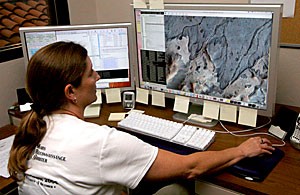Students from all over the world can now help control a multi-million dollar space camera in orbit around Mars.
The HiRISE Image Targeting Challenge invites people of all ages to suggest where the UA-operated HiRise camera on NASA’s Mars Reconnaissance Orbiter should take photos.
Based on the images that return, students can analyze the photographed areas for signs of water and ice.
The Challenge had a successful pilot run in the spring, when suggestions from around 1,500 students came in and 12 images were chosen, said Virginia Gulick, who leads the HiRISE education outreach program. The Challenge has been extended to run until November 2008, when the primary science phase of the Mars mission ends.
“”It’s giving students and teachers the experience of what scientists do on a daily basis,”” Gulick said.
“”Each time we do it, we get a little bit better,”” she added. “”I hope to continue this as long as possible and make it part of what we do.””
The Challenge is a joint project between HiRISE and the NASA Quest program, an Internet outreach program.
Since registration began this fall, HiRISE has already received more than 300 suggestions representing more than 3,500 students in countries including Hungary, Nepal and Iran.
“”It’s amazing where they all come from,”” Gulick said.
The HiRISE team guides the students in their choices of pictures. Once the pictures are taken, the students help write the captions for them, as well, said Alfred McEwen, UA professor and principal investigator of the Lunar and Planetary Laboratory.
The students’ work is being integrated with the rest of the work being done with the camera, he added.
Yet, the timeslots for photos are often limited by the positioning of the camera and the possibility of inclement
weather, a common concern on Mars with its enormous dust storms.
“”We’ll take as many as we can,”” Gulick said.
This week’s chosen image comes from Max Fomitchev, a computer science and engineering professor at Penn State University. His image shows a 6-kilometer area in central Aram Chaos, a crater north of Mars’ equator.
“”There’s been some good, interesting science images,”” McEwen said.
The Challenge’s main goal is to educate students about and enhance their interest in Mars.
“”They will learn what it’s like to be a science team,”” Gulick said. “”It’s a neat thing for them to do.””









